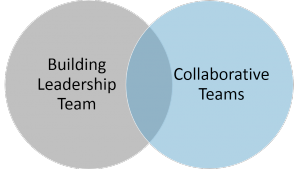LEADERSHIP IN PRACTICE
Establish Collaborative Culture and Climate

Collaborative Team Structures
The building leader must establish collaborative team structures, including a building leadership team and grade level/content area collaborative teams. Both teams are alike in that they analyze data and use this analysis to inform future actions. The teams may differ in the levels of data examined and the types of future actions taken.
Building Leadership Teams
A building leadership team is typically comprised of individuals who represent different departments, grade levels, and roles within the organization. This team works interdependently toward common goals in order to create and successfully sustain school improvement efforts. They analyze building and classroom level student data and well as strengths and weaknesses related to instruction and social-behavioral needs.
Grade level/content collaborative teams are typically comprised of teachers of the same grade level and/or content area and should include all instructional staff on at least one team. These teams maintain unity throughout curriculum, instruction, and assessment to align and implement the standards within each content area for the specific grade level and/or content area. They analyze building and classroom level student data and well as strengths and weaknesses related to instruction and social-behavioral needs to determine instructional effectiveness and student learning. These teams use data to inform future instruction. Team membership should include: Do you have a building leadership team already established? What are the functions of the team and the team members’ roles and responsibilities? Do you have collaborative teams established across grade levels or content areas? Are all staff on at least one of these teams? What are the functions of the team and what are the team members’ roles and responsibilities? If established, are both or either of these teams ensuring they are running efficiently and effectively?
Collaborative Teams

